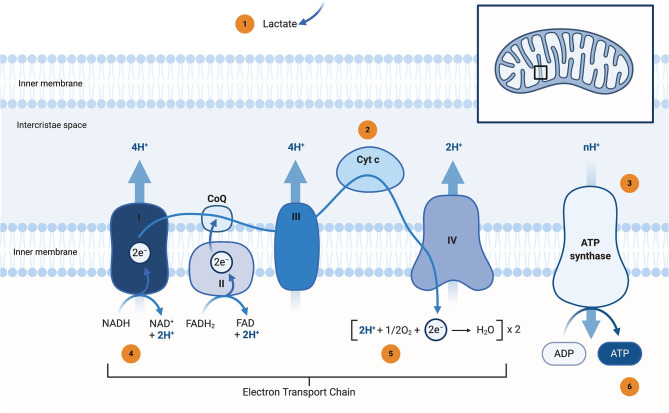Figure 1.
Schematic representation of the Electron Transport Chain (ETC) and potential neuroimaging modalities to assess bioenergetic disturbances in Parkinson's disease (PD) patients. The localisation of the ETC complexes is highlighted in the right upper corner. Lactate (as a surrogate marker for mitochondrial dysfunction) can be assessed by 1H-MRSI (1). bNIRS devices can measure Cyt c oxidation state under dynamic conditions (2). ADP and ATP can either be measured under dynamic (ATP synthase activity) by 31P-MRSI magnetisation transfer (3) or static conditions (regular 31P-MRSI) (6). Complex I activity can be studied by 31P-MRSI (by measuring the NAD+/NADH ratio) or via a radiolabeled PET tracer (18F-BCPP-EF) (4). Many different approaches can be used to study in-vivo oximetry and oxygen turnover. The most common non-invasive methods are 17O-MRI (direct measurement) or a combination of BOLD and ASL imaging (indirect measurement by employing different physiological models) (5). 1H-MRSI, proton magnetic resonance spectroscopy imaging; 17O-MRI, oxygen magnetic resonance imaging; 18F-BCPP-EF, 2-tert-butyl-4-chloro-5-[6-[2-2[([18F]fluoroethoxy)-ethoxy]-pyridin-3-ylmethoxy]-2H]-pyridazin-3-one; 31P-MRSI, phosphorus magnetic resonance spectroscopy imaging; ADP, adenosine diphosphate; ASL, arterial spin labelling; ATP, adenosine triphosphate; bNIRS, broadband near-infrared spectroscopy; BOLD, blood oxygen-dependent imaging, functional MRI; CoQ, coenzyme Q; Cyt c. Cytochrome c; e−, electron; FAD, flavin adenine dinucleotide (oxidised form); FADH2, flavin adenine dinucleotide (reduced form); H+, proton; H2O, water; I, complex I; NADH, ubiquinone oxidoreductase, Type I NADH dehydrogenase; II, complex II, Succinate dehydrogenase, succinate-coenzyme Q reductase; III, complex III, coenzyme Q: cytochrome c—oxidoreductase; IV, complex IV, cytochrome c oxidase; MRI, magnetic resonance imaging; n, number; NAD+, nicotinamide dinucleotide (oxidised form); NADH, nicotinamide dinucleotide (reduced form); O2, molecular oxygen; PD, Parkinson's disease; PET, positron emission tomography. Created with https://biorender.com/.

